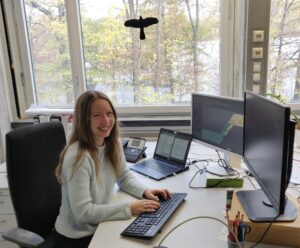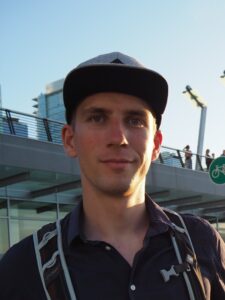I’m Anna Schwarz, a PhD student in the Numerics Research Group at the Institute of Aerodynamics and Gas Dynamics (IAG) of the University of Stuttgart (USTUTT-IAG).

I studied Aerospace Engineering at the University of Stuttgart, followed by a PhD in the Numerics Research Group of the IAG. There I worked on various research topics: the increase in global warming demands a sustainable and low-emission aerospace industry, effecting especially jet engines. Here, performance degradation through surface deformation of blades during flight by solid particles ingested in the ambient air is very crucial for the overall fuel consumption. Since experimental investigations are difficult/impossible, numerical simulations are inevitable to gain insight into such mechanisms. During my PhD, suitable numerical methods enhanced by data-driven approaches have been developed/applied to simulate turbulent particle-laden flow around complex geometries such as jet engine blades and to predict surface deformations caused by impacting particles and the resulting performance losses. This will guide the design of future blades such that performance degradation can be reduced and climate targets are reached. This background and a strong interest in working with international partners and on various cutting-edge research topics led me to join the CEEC project.
During the CEEC project, I will coordinate the work associated with the six lighthouse cases of CEEC and work on our own lighthouse case dealing with the simulation of the shock-boundary layer interaction and buffet on wings at the edge of the flight envelope. Since the resolution requirements to fully resolve the turbulent structures of the flow around the wing, especially in the near wall region, are too high, reduced numerical methods are necessary, where not all turbulent features are fully resolved, called large-eddy simulation. If the behaviour of the fluid in the near-wall region also cannot be resolved in detail, but has to be approximated by analytical models, it’s called a wall-modelled large-eddy simulation. To this end, state-of-the-art analytical models for the near-wall region in large eddy simulations will be further developed/enhanced using data-driven techniques such as artificial neural networks together with all CEEC partners that also plan to use wall-models in their lighthouse cases , such as BSC with the high fidelity aeroelastic simulation of the SFB 401 wing and FAU with their Merchant Hull lighthouse case. I will also work on a topic related to a different lighthouse case, investigating the flow around a ship hull of a merchant ship in model scale via large-eddy simulations and wall-modelling. For this lighthouse case, uncertainties in statistical quantities have to be quantified to control and report errors in the simulation results, and also for intelligent design of the simulations. Since the simulation has to be carried out on high-performance computing clusters, a fully automated toolchain to carry out several simulations is necessary to finally quantify uncertainties in the simulation setup design. This will be accomplished together with the relevant CEEC partners (FAU/KTH) of the Merchant Hull lighthouse case.
My ultimate goal in the project is that the results of our light-house case, shock-boundary layer interaction and buffet on a wing, are promising and provide new insights and that the simulation can be efficiently carried out on current high-performance clusters. Hence,
we also seek strong performance improvements of our current CFD high-fidelity solver FLEXI on various high-performance computing clusters including GPU systems. Apart from that I would like to gain experience, collaborate with different (international) partners, and dive into new research topics.


